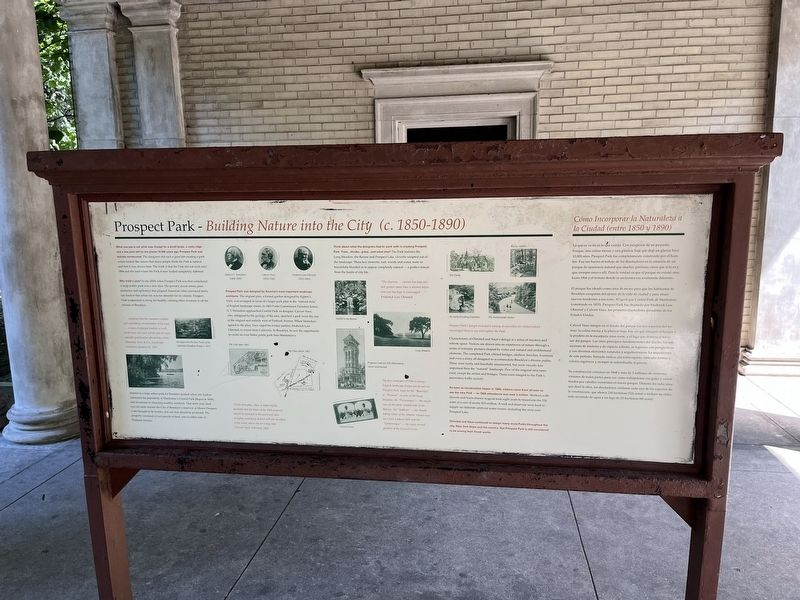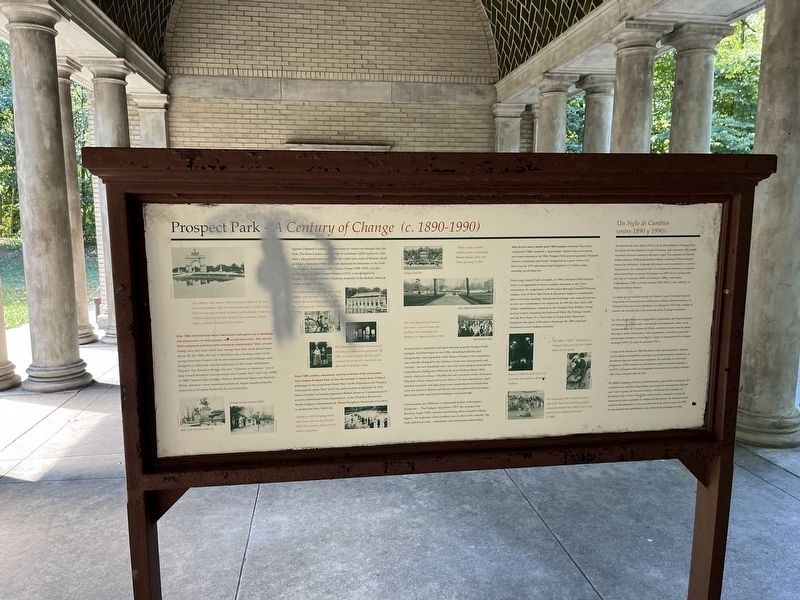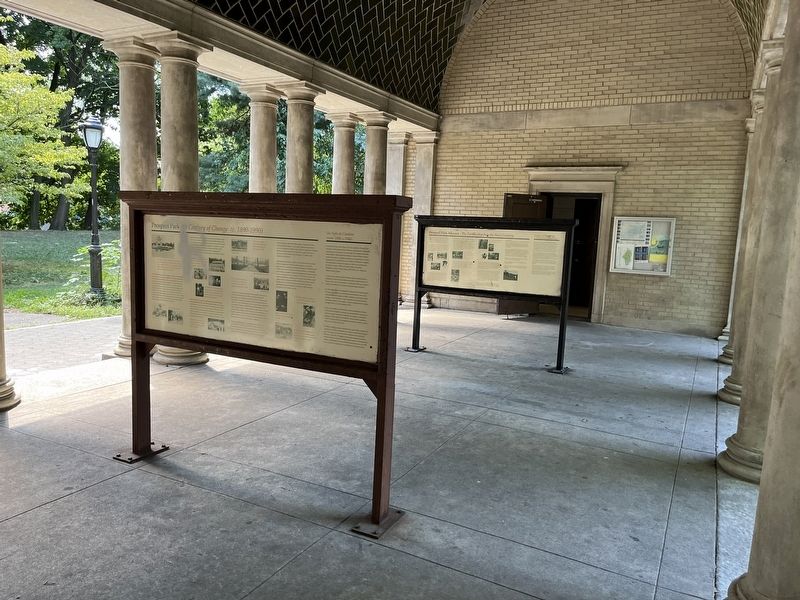Prospect Park in Brooklyn in Kings County, New York — The American Northeast (Mid-Atlantic)
Prospect Park
Prospect Park - Building Nature into the City (c. 1850-1890)
What you see is not what was. Except for a small forest, a rocky ridge and a low plain left by the glacier 10,000 years ago. Prospect Park was entirely constructed. The designers did such a good job creating a park which looked like nature that many people think the Park is natural and that it was always here. The truth is that the Park did not exist until 1866 and the land where the Park is now looked completely different.
Why build a park? In the 1850s when Prospect Park was first considered, a public park was a new idea. The poverty, social unrest, poor sanitation and epidemics that plagued American cities convinced many city leaders that urban life was too stressful for its citizens. Prospect Park was created to bring the healthy, calming effect of nature to all the citizens of Brooklyn.
"…escaping from the cramped, confined and controlling circumstances of the town…a sense of enlarged freedom is to all, at all times, the most certain and the most valuable gratification afforded by a Park."
Olmsted, Vaux & Co., Landscape Architects, January 24, 1866
Interest in a large urban park for Brooklyn peaked when city leaders witnessed the popularity of Manhattan's Central Park (begun in 1858), and its success in attracting wealthy residents. That same year, land was set aside around the City of Brooklyn's reservoir at Mount Prospect, a site thought to be healthy and one that should be protected. The property consisted of two parcels of land, one on either side of Flatbush Avenue.
Prospect Park was designed by America's most important landscape architects. The original plan, a formal garden designed by Egbert L. Viele, was scrapped in favor of a larger park plan in the "natural style" of English landscape architects. In 1865 Parks Commission President James S.T. Stranahan approached Central Park co-designer, Calvert Vaux, who, intrigued by the geology of the area, sketched a park twice the size of the original and entirely west of Flatbush Avenue. When Stranahan agreed to the plan, Vaux urged his former partner, Frederick Law Olmsted, to return from California. In Brooklyn, he saw the opportunity to create an even better public park than Manhattan's.
"In the first place, then, it seems highly desirable that the limits of the Park property should be extended to the south and west… Ahighly interesting district will also be added to the south, and a site for a large lake…"
Calvert Vaux, February, 1865
Think about what the designers had to work with in creating Prospect Park. Trees…shrubs…grass…and what else? The Park features the Long Meadow, the Ravine and Prospect Lake, cleverly sculpted out of the landscape. These key elements, turf, woods and water, were so beautifully blended as to appear completely natural — a perfect retreat from the bustle of city life.
"The observer…cannot but hope for still greater space than its obvious before him and this hope is encouraged…"
Frederick Law Olmsted
THe four principles of 18th Century landscape can be seen in Prospect Park. Look for the "Beautiful", or "Pastoral", as seen in the Long Meadow; the "Picturesque" — the roughness of the steep, wooded hills of the Ravine; the "Sublime" — the breathtaking views of the Atlantic Ocean once seen from Lookout Hill; and the "Gardenesque" — the exotic formal gardens of the Concert Grove.
Prospect Park's design included a variety of amenities for visitors which encouraged them to use and explore the Park.
Characteristic of Olmsted and Vaux's design is a sense of mystery and infinite space. Visitors are drawn into an experience of nature through a series
As soon as construction began in 1866, visitors came from all over to see the new Park — in 1868 attendance was over 2 million. Workers with shovels and horse-drawn wagons took eight years to transform the 526 acres at a cost of nearly $10 million. A well and reservoir were built to supply an elaborate artificial water course, including the sixty-acre Prospect Lake.
Olmsted and Vaux continued to design many more Parks throughout the city, New York State and the country. But Prospect Park is still considered to be among their finest works.
Lo que se ve no es lo que existía. Con excepción de un pequeño bosque, una colina rocosa y una planicie baja que dejó un glaciar hace 10,000 años, Prospect Park fue completamente construido por el hombre. Fue tan bueno el trabajo de los diseñadores en la creación de un parque de apariencia natural que muchas personas creen que sí lo es y que siempre estuvio allí. Pero la verdad es que el parque no existió sino hasta 1866 y el terreno donde se encuentra era totalmente diferente.
El parque fue ideado como área de recreo para que los habitantes de Brooklyn escaparan del ajetreo de la vida de ciudad y para atraer nuevos residentes a esa zona. Al igual que Central Park de Manhattan (construido en 1855), Prospect Park fue diseñado por Frederick Law Olmsted y Calvert Vaux, los primeros diseñadores paisajistas de los Estados Unidos.
Calvert Vaux integró en el diseño del parque los dos aspectos del ferreno: la colina rocosa y la planicie baja. Fue así que imaginó el bosque y la pradera en la escarpada zona norte, y el lago que domina el tercio sur del parque. Los otros principios fundamentales del diseño, las sensaciones de misterio y de espacio infinito, se lograron con perspectivas y con diversos elementos naturales y arquitectónicos. La arquitectura de este períodico, llamada rústica, era extravagante, utilizaba formas y colores orgánicos y siempre se subordinaba al paisaje.
Su construcción comenzó en 1868 y más de 2 milliones de visitantes vinieron de todas partes para ver cómo trabajadores con palas y carros tirados por caballos construían el nuevo parque. Durante los ocho años que duró la obra, los diseñadores cuidaron cada uno de los aspectos de la construcción, que abarca 210 hecatáreas (526 acres) e incluye un elaborado recorrido de agua y un lago de 25 hectáreas (60 acres).
The Soldiers's and Sailors' Memorial Arch (1889-92) by John Duncan heralded a shift in architectural styles. Grand Army Plaza's re-design included sculpture by Brooklynite Frederick William MacMonnies, four 50-foot Doric columns, electric lights, a granite wall and round shelters.
After 1880, Olmsted and Vaux's naturalistic style gave way to buildings and monuments of white granite, marble and terra cotta. Why did the Park's entrances and structures change so dramatically? Many people change how they look when they change how they think about themselves. By the 1880s, the city of Brooklyn was a leading center of young American Empire and its new monuments and buildings were designed to reflect the classical influences of the Greek and Roman Empires. The Brooklyn Bridge, the new "Gateway to America," was a step toward Brooklyn's incorporation into Greater New York City (1898). In 1888 Charles Follen McKim, William Rutherford Mead and Stanford White, America's most renowned architects began transforming the entrances to Prospect Park with the new formality.
Against Olmsted's wishes, the neo-classical vision was brought into the Park. The Rose Garden and the Vale Cashmere (1895) replaced a children's playground and pool while the white terra cotta of McKim, Mead & White's Peristyle (1904) set a new standard for structures in the Park. The dramatic Boathouse (1905), Tennis House (1909-1910), and this building, the Willink Comfort Station (1913), were designed by Frank J. Helmle and Ulrich J. Huberty, formerly of the McKim, Mead & White architecture firm.
The Boathouse contained the boat rental, kitchen, soda fountain, Ladies' Restroom, and on the second floor, a dining room, all in the guise of a 16th-century Italian library.
The Paladian-style Tennis House provided lockers for lawn tennis equipment. By 1885, less than a decade after the sport's introduction in the U.S., there were over 400 clubs in Brooklyn alone.
Since 1900, politics, economics and the invention of the automobile have shaped Prospect Park, as has the increase in leisure time. Political patronage in the years from World War I to the Depression left Prospect Park and the entire New York City parks system in disrepair. In 1934, Mayor Fiorello LaGuardia appointed Robert Moses as Commissioner of a newly-centralized Parks Department. Under President Roosevelt's Works Progress Administration, Moses brought in thousands of workers to modernize New York City.
Opened in 1928, the playground near Ocean Avenue was Prospect Park's first modern play area with built-in equipment.
"Parks are the outward visible symbol of democracy."
Robert Moses, New York Times, January 9, 1956
The vista that defined Olmsted and Vaux's Concert Grove was sacrificed to accommodate the Wollman Ice Skating Rink in 1961.
As more active recreation and sports became popular, Prospect Park changed. Facilities begun in the 1920s, including ballfields and playgrounds, were expanded under Moses. Prospect Park's perimeter was radically changed by the addition of four new playgrounds and "tot lots," the new bandshell and a new zoo. Later projects included the Long Meadow Ballfields (1959) and the Kate Wollman Rink (1961), which, while providing a valuable and safe recreation center, destroyed Olmsted's Music Island and Lower Terrace. To ease maintenance, park benches, fountains and light poles were standardized and dead trees were not replaced. Entries and Drives were straightened to accommodate faster traffic and several buildings were destroyed.
Unfortunately, the 1950s saw a substantial decline in Brooklyn's prosperity — The Dodgers' departure (1957); the closing of the Brooklyn Eagle (1955); and the snowballing effect of another Moses legacy — the highways which enabled many to flee to the suburbs. The Park suffered as well — attendance and maintenance diminished.
How do you save a public park? With people, of course. The Park's centennial (1966), inspired a "grass roots" preservation movement and some restoration. In 1980, Prospect Park was designated a National Historic Landmark and finally recognized as a great work of art. However, by 1979 attendance had dropped to 1.7 million visits annually, an all-time low.
Following Central Park's example, in 1980 a Prospect Park Administrator was appointed to focus available resources on the park's renaissance. In cooperation with Brooklyn Borough President Howard Golden, City of New York Parks & Recreation began a revitalization plan to increase usership. Abandoned buildings were restored and put to new use; maintenance was improved. In 1993 the Zoo, after a $36 million rehabilitation, reopened as the Prospect Park Wildlife Center. Annual events, including the Halloween Walk, the Fishing Contest, and the New Year's Eve Fireworks and Grand Army Plaza have recaptured the spirit of Brooklyn's backyard. By 1994 visits had increased to over 5 million annually.
The Park's "VIPP's" (Volunteers in Prospect Park), now log over 20,000 hours of work yearly.
Begun in 1980, the New Year's Eve Fireworks have become a Brooklyn tradition.
The reopening of the Oriental Pavilion. One of the Park's few surviving original structures designed by Calvert Vaux, it was rescued from collapse and restored in 1988.
El resideño de Gran Army Plaza y de la otra entrada a Prospect Park fue parte del Movimiento Ciudad Hermosa, una expresión del orgullo nacional previa al comienzo del nuevo siglo. Los arquietectos Charles Follen McKim, William Rutherford Mead y Stanford White transformaron las entradas y el paisaje del parque con monumentos y nuevas instalaciones. En contraposición a los diseños de Olmsted, la arquitectura formal llegó al interior del parque en 1895 con la construcción del Vale of Cashmire (1895), el Peristyle (1895), y más tarde, el Boathouse (1905), el Tennis House (1909-1910) y este edeficio el Willink Comfort Station.
La etapa que se extiende desde la Primera Guerra Mundial hasta la Depresión se caracterizó por influencias políticas desenfrenadas y el Prospect Park cayó en el abandono. La década de 1920 trajo consigo el tránsito de automóviles y las primeras áreas de juego modernas.
En 1934, Robert Moses fue designado Comisionado del Departamento de Parques, que había sido centralizado recientemente. Junto con la Administración de Progreso de Obras, construyó cuatro nuevas áreas de juego y zonas destinadas a niños pequeños, el escenario para presentaciones artísticas y el zoológico. Luego se inauguraron los campos de juego (1959) y la pista de patinaje (1961).
A fines de la década de 1960 Brooklyn estaba en decadencia: disminuyó la afluencia de público al parque, su mantenimiento emperó y se perdieron algunas estructuras originales. Sin embargo, el centenario del parque (1966) inspiró un movimiento conservacionista popular y en 1975 el Prospect Park fue designado monumento nacional y reconocido como una gran obra de arte.
En 1980 se designó al primer Administrador, quien debía encargarse de centralizar los recursos disponibles para lograr el renacimiento del parque. Con el apoyo de Howard Golden, Presidente del Condado de Brooklyn, City of New York Parks & Recreation comenzó un plan de restauración para aumentar la utilización del parque. Se restauraron los edificios abandonados y se los acondicionó para nuevos usos. En 1995 la concurrencia ha aumentado a seis milliones de persons por año.
Topics and series. This historical marker is listed in these topic lists: Architecture • Landmarks • Parks & Recreational Areas • Sports. In addition, it is included in the National Historic Landmarks series list. A significant historical date for this entry is January 24, 1866.
Location. 40° 39.776′ N, 73° 57.81′ W. Marker is in Brooklyn, New York, in Kings County. It is in Prospect Park. Marker can be reached from Flatbush Avenue north of Ocean Avenue, on the left when traveling north. Touch for map. Marker is at or near this postal address: 7 Flatbush Ave, Brooklyn NY 11225, United States of America. Touch for directions.
Other nearby markers. At least 8 other markers are within walking distance of this marker. Prospect Park Alliance / Welcome to Prospect Park (here, next to this marker); Henry Christensen III (about 300 feet away, measured in a direct line); Carousel (about 300 feet away); Remember the Malbone Street Wreck (about 400 feet away); Welcome (about 500 feet away); Johnny Appleseed Rambo Apple (about 500 feet away); Living Land Acknowledgement (about 500 feet away); Ginger (about 600 feet away). Touch for a list and map of all markers in Brooklyn.
Also see . . . Prospect Park - National Archives. National Register of Historic Places documentation (Submitted on March 3, 2024, by Anton Schwarzmueller of Wilson, New York.)
Credits. This page was last revised on March 3, 2024. It was originally submitted on August 15, 2022, by Devry Becker Jones of Washington, District of Columbia. This page has been viewed 120 times since then and 25 times this year. Photos: 1, 2, 3. submitted on August 15, 2022, by Devry Becker Jones of Washington, District of Columbia.


